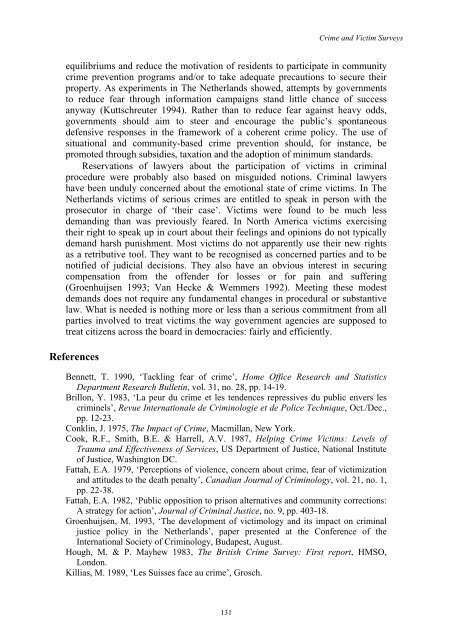Crime and victim surveys - Australian Institute of Criminology
Crime and victim surveys - Australian Institute of Criminology
Crime and victim surveys - Australian Institute of Criminology
Create successful ePaper yourself
Turn your PDF publications into a flip-book with our unique Google optimized e-Paper software.
<strong>Crime</strong> <strong>and</strong> Victim Surveys<br />
equilibriums <strong>and</strong> reduce the motivation <strong>of</strong> residents to participate in community<br />
crime prevention programs <strong>and</strong>/or to take adequate precautions to secure their<br />
property. As experiments in The Netherl<strong>and</strong>s showed, attempts by governments<br />
to reduce fear through information campaigns st<strong>and</strong> little chance <strong>of</strong> success<br />
anyway (Kuttschreuter 1994). Rather than to reduce fear against heavy odds,<br />
governments should aim to steer <strong>and</strong> encourage the public’s spontaneous<br />
defensive responses in the framework <strong>of</strong> a coherent crime policy. The use <strong>of</strong><br />
situational <strong>and</strong> community-based crime prevention should, for instance, be<br />
promoted through subsidies, taxation <strong>and</strong> the adoption <strong>of</strong> minimum st<strong>and</strong>ards.<br />
Reservations <strong>of</strong> lawyers about the participation <strong>of</strong> <strong>victim</strong>s in criminal<br />
procedure were probably also based on misguided notions. Criminal lawyers<br />
have been unduly concerned about the emotional state <strong>of</strong> crime <strong>victim</strong>s. In The<br />
Netherl<strong>and</strong>s <strong>victim</strong>s <strong>of</strong> serious crimes are entitled to speak in person with the<br />
prosecutor in charge <strong>of</strong> ‘their case’. Victims were found to be much less<br />
dem<strong>and</strong>ing than was previously feared. In North America <strong>victim</strong>s exercising<br />
their right to speak up in court about their feelings <strong>and</strong> opinions do not typically<br />
dem<strong>and</strong> harsh punishment. Most <strong>victim</strong>s do not apparently use their new rights<br />
as a retributive tool. They want to be recognised as concerned parties <strong>and</strong> to be<br />
notified <strong>of</strong> judicial decisions. They also have an obvious interest in securing<br />
compensation from the <strong>of</strong>fender for losses or for pain <strong>and</strong> suffering<br />
(Groenhuijsen 1993; Van Hecke & Wemmers 1992). Meeting these modest<br />
dem<strong>and</strong>s does not require any fundamental changes in procedural or substantive<br />
law. What is needed is nothing more or less than a serious commitment from all<br />
parties involved to treat <strong>victim</strong>s the way government agencies are supposed to<br />
treat citizens across the board in democracies: fairly <strong>and</strong> efficiently.<br />
References<br />
Bennett, T. 1990, ‘Tackling fear <strong>of</strong> crime’, Home Office Research <strong>and</strong> Statistics<br />
Department Research Bulletin, vol. 31, no. 28, pp. 14-19.<br />
Brillon, Y. 1983, ‘La peur du crime et les tendences repressives du public envers les<br />
criminels’, Revue Internationale de Criminologie et de Police Technique, Oct./Dec.,<br />
pp. 12-23.<br />
Conklin, J. 1975, The Impact <strong>of</strong> <strong>Crime</strong>, Macmillan, New York.<br />
Cook, R.F., Smith, B.E. & Harrell, A.V. 1987, Helping <strong>Crime</strong> Victims: Levels <strong>of</strong><br />
Trauma <strong>and</strong> Effectiveness <strong>of</strong> Services, US Department <strong>of</strong> Justice, National <strong>Institute</strong><br />
<strong>of</strong> Justice, Washington DC.<br />
Fattah, E.A. 1979, ‘Perceptions <strong>of</strong> violence, concern about crime, fear <strong>of</strong> <strong>victim</strong>ization<br />
<strong>and</strong> attitudes to the death penalty’, Canadian Journal <strong>of</strong> <strong>Criminology</strong>, vol. 21, no. 1,<br />
pp. 22-38.<br />
Fattah, E.A. 1982, ‘Public opposition to prison alternatives <strong>and</strong> community corrections:<br />
A strategy for action’, Journal <strong>of</strong> Criminal Justice, no. 9, pp. 403-18.<br />
Groenhuijsen, M. 1993, ‘The development <strong>of</strong> <strong>victim</strong>ology <strong>and</strong> its impact on criminal<br />
justice policy in the Netherl<strong>and</strong>s’, paper presented at the Conference <strong>of</strong> the<br />
International Society <strong>of</strong> <strong>Criminology</strong>, Budapest, August.<br />
Hough, M. & P. Mayhew 1983, The British <strong>Crime</strong> Survey: First report, HMSO,<br />
London.<br />
Killias, M. 1989, ‘Les Suisses face au crime’, Grosch.<br />
131















